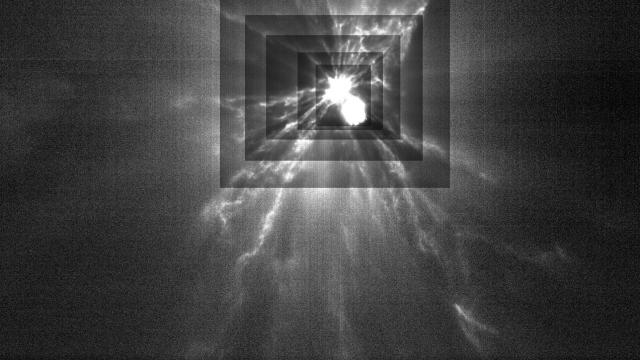Earlier this week, NASA announced that its DART spacecraft successfully moved an asteroid by a few dozen feet. This raises a valid question: How the heck did scientists figure this out, given that Dimorphos is nearly 7 million miles away? Needless to say, this task required some clever astronomy and a veritable village of astronomers.
NASA’s Double Asteroid Redirection Test, or DART, shortened the amount of time it takes Dimorphos to orbit Didymos, as the spacecraft pushed the target asteroid slightly closer to its larger companion. Dimorphos’s orbital period around Didymos used to be 11 hours and 55 minutes, but it’s now 11 hours and 23 minutes — a change of 32 minutes, give or take two minutes. That represents “tens of meters” in terms of the altered distance, as Nancy Chabot, DART coordination lead at the Johns Hopkins Applied Physics Laboratory, told reporters on Tuesday.
A ‘watershed moment’
Speaking at the same press briefing, NASA administrator Bill Nelson described the successful test as a “watershed moment for humanity.” Indeed, it marks the first time that our species has purposefully changed the motion of a celestial object. Critically, it’s also the first full-scale demonstration of an asteroid deflection strategy, one that could eventually protect us from a bona fide asteroid threat.
See more on this story: Why DART is the most important mission ever launched to space
Dimorphos doesn’t endanger Earth, but it did offer an ideal platform for testing kinetic impactor technology. The 608 kg DART spacecraft, following a 10-month journey to the binary asteroid system, plowed into the 160.02 m-wide (160-metre) asteroid at speeds reaching 22,531 km per hour (22,500 kilometers per hour). DART struck the asteroid with razor-like precision on September 26, but it wasn’t immediately obvious if the impact had any kind of effect.
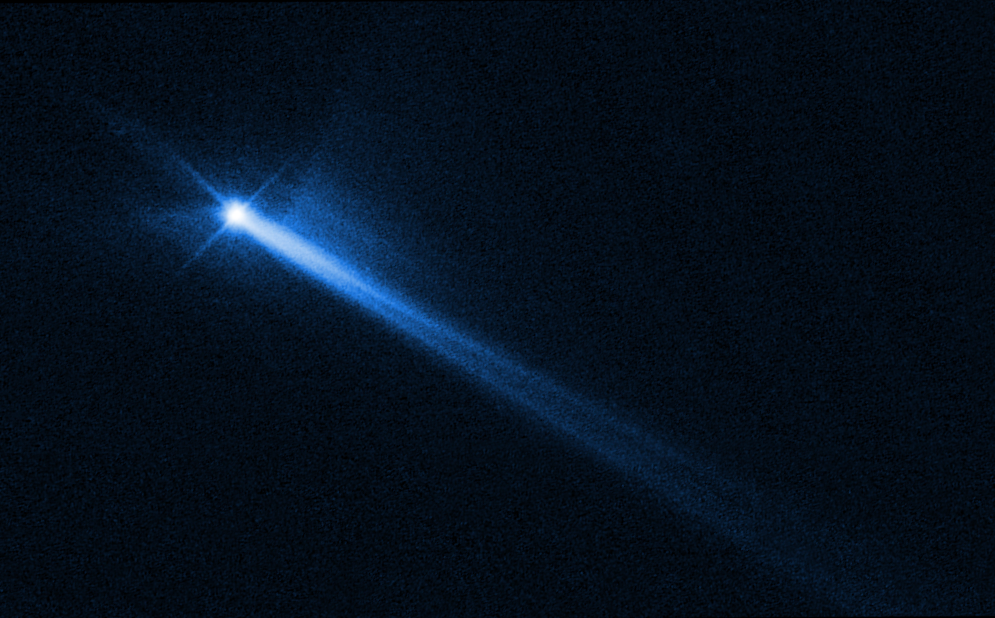
That the $US308 ($428) million DART test did something to the unsuspecting asteroid was immediately obvious, with both space-based and ground-based observations revealing a dramatic plume and comet-like tail in the hours and days following the impact. It took about two weeks, however, for astronomers to confirm the new orbital dynamics imposed upon the Didymos-Dimorphos system. Two separate datasets were needed for the task, one optical and the other radio, but both pointed to the same answer: 11 hours and 23 minutes.
Catching an altered eclipse
Optical data came from ground-based observatories around the world, including the Las Cumbres Observatory (LCO) telescopes in South Africa and the Southern Astrophysical Research Telescope in Chile. A limitation of optical telescopes is that, due to the distance and small size of the Didymos-Dimorphous system, the two objects are seen as a single glowing dot. The asteroids are just 0.75 miles (1.2 km) apart, with Didymos, the larger of the two, measuring just 2,560 feet (780 meters) wide.
Ground-based optical telescopes can’t distinguish between the two, but that doesn’t mean Dimorphos is invisible to these eyes. The brightness of Didymos temporarily drops by around 10% each time Dimorphos passes in front of it. It’s through these clock-work eclipses that astronomers knew Dimorphos’s orbital period prior to the test and how they’re able to determine it now. That Dimorphos passes in front of Didymos from our perspective on Earth is fortuitous, and a key reason for why this system was chosen for the DART test.
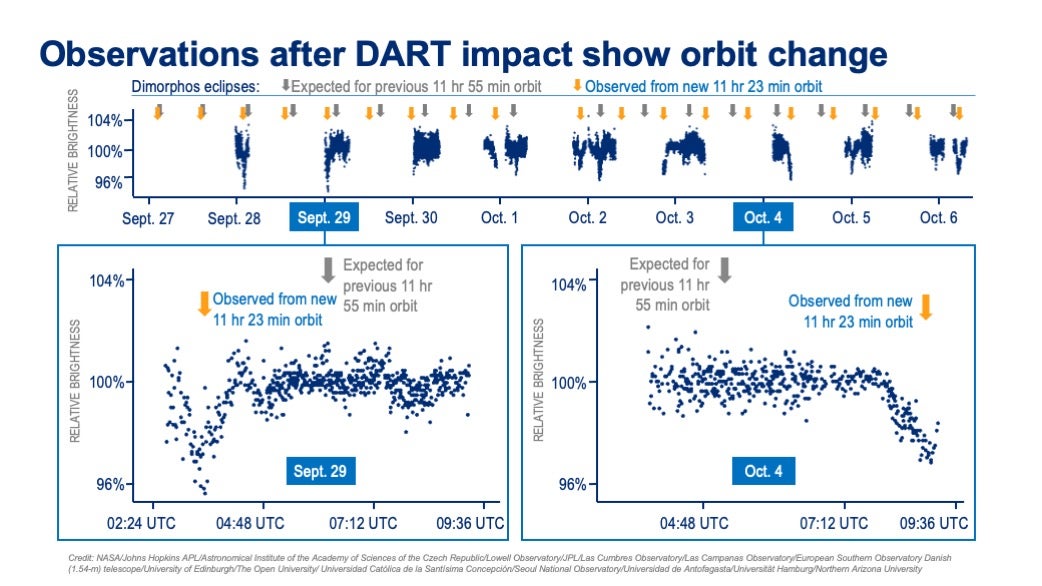
Optical observatories across the world performed continuous observations over hours-long timescales. “Since the [orbital] period was close to 12 hours, having telescopes in South Africa roughly six hours away from Chile meant we could capture the other times when Dimorphos went behind or in front of Didymos we couldn’t see from Chile,” Tim Lister, an astronomer with LCO, explained in a South African Astronomical Observatory press release. “This really helped nail down the new period and the amount of change caused by the DART impact.”
Detecting ‘faint radar echoes’
The radar data came from NASA JPL’s Goldstone planetary radar in California and the NSF’s Green Bank Observatory in West Virginia. Unlike optical telescopes, radar “can get distinct signals from both objects directly,” said Chabot.
Radio imagery from the two observatories, taken each night during a two-week campaign, were combined to create before-and-after views of the binary asteroid system. This allowed astronomers to measure the “difference between where Dimorphos is observed compared to where it would have been with the original orbit,” as NASA explained in its press package.
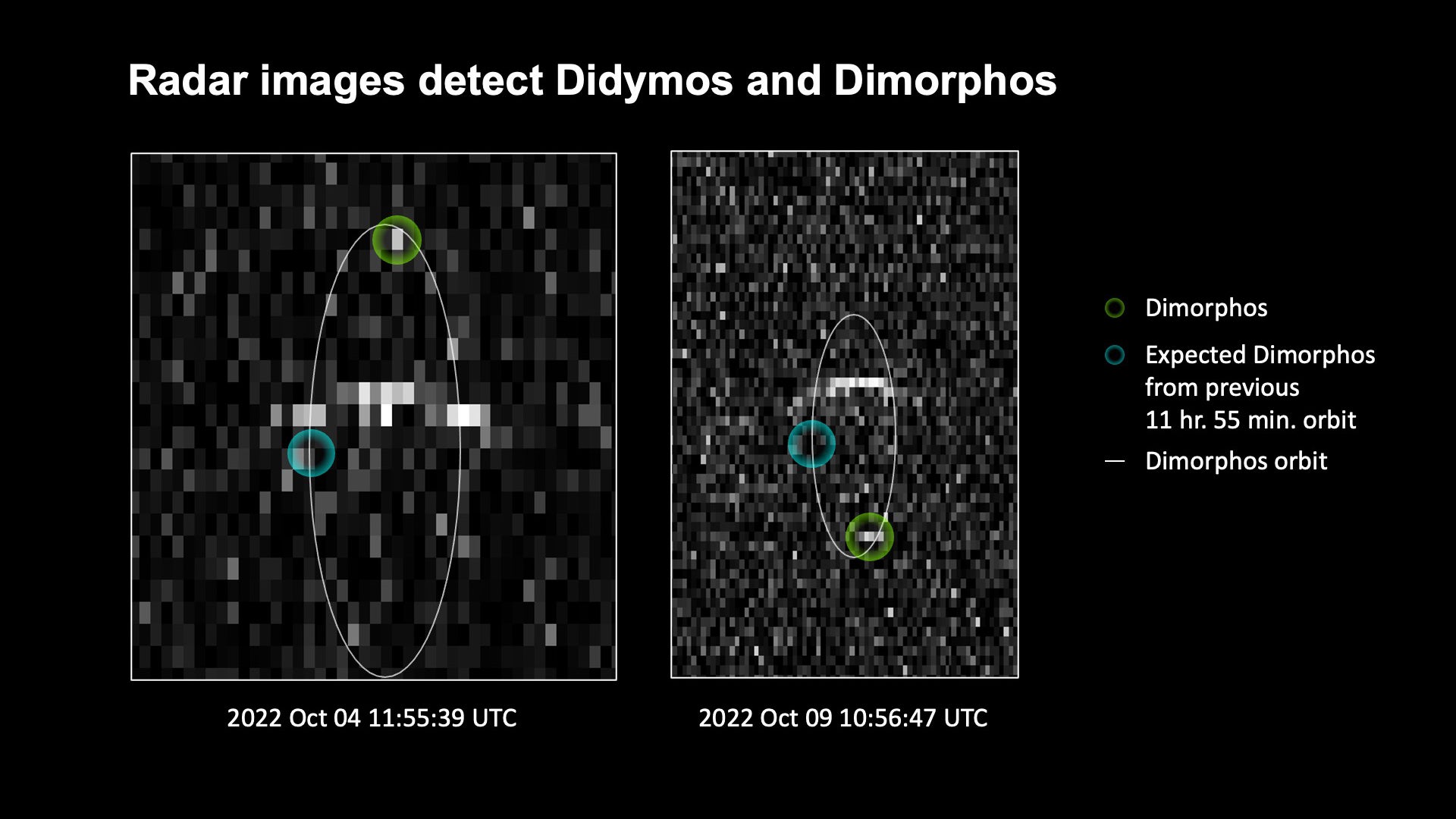
“The Green Bank Telescope’s large collecting area makes it extremely sensitive and a prime receiving station to detect these faint radar echoes,” Jim Jackson, director of the Green Bank Observatory, explained in a statement. “These radar measurements” were key to determining “just how dramatic the event really was by sensing changes in its orbit around Didymos and definitively establishing its deflection.”
The “two independent methods” provided “the same answer,” said Chabot, in reference to Dimorphos’s new 11 hour and 23 minute orbital period. She credited the international team for getting “onto this very quickly.” But plenty of work remains.
The beginning of the beginning
Indeed, much is unknown about the effect of the experiment. DART was a rousing success, but it’s clear that scientists still have lots to learn about kinetic impactors and the art of deflecting asteroids.
For example, astronomers need to refine their estimates of Dimorphos’s mass, shape, density, and surface composition. This will help them to understand how the DART spacecraft transferred its momentum into its target and how the ensuing effects contributed to the observed orbital shift.
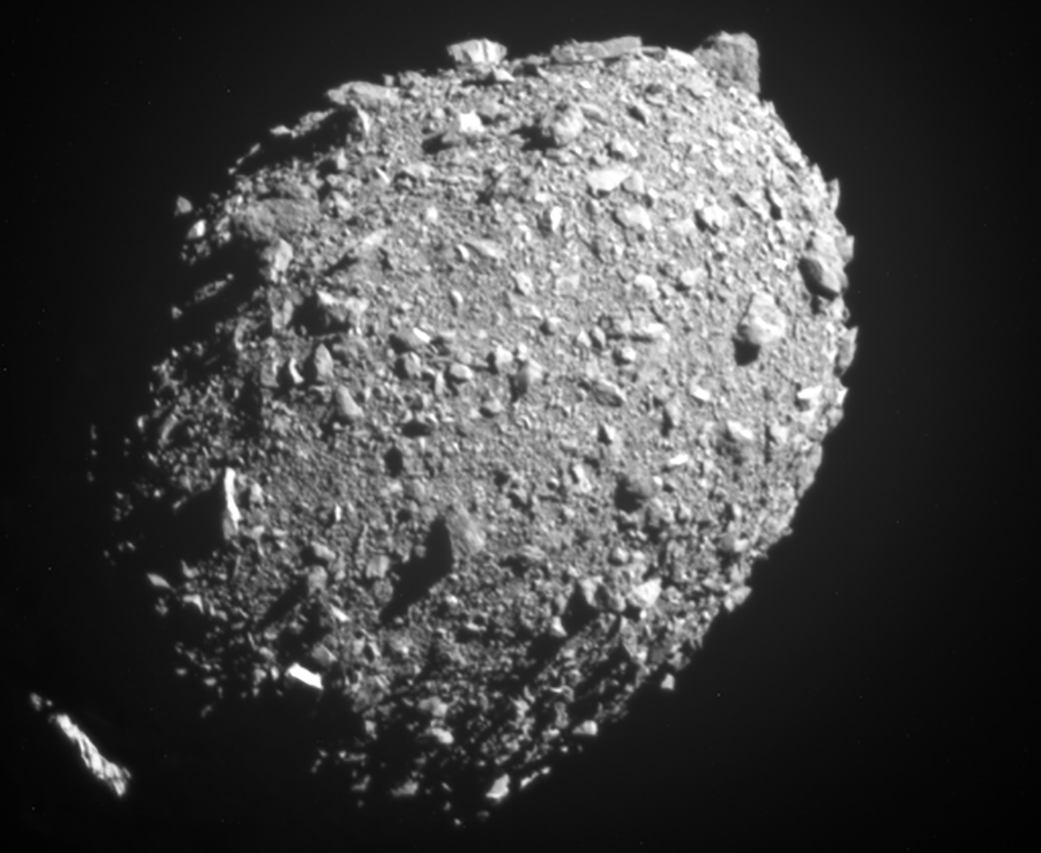
During Tuesday’s press briefing, Tom Statler, DART program scientist at NASA, said the recoil from the debris blasting off the surface was a major contributor to the orbital change. This is likely a consequence of Dimorphos’s physical makeup as a rubble pile asteroid, as opposed to it being a compact and cohesive rock. Statler also wondered if Dimorphos is now wobbling as a result of the impact. Astronomers are keeping a close watch on the system to refine their preliminary estimates and observe any further changes to the binary pair.
The European Space Agency is planning a follow-up mission to visit the asteroids up-close. The HERA probe, scheduled to launch in 2024, will observe Dimorphos in late 2026 and send back images and other data to help us better understand the effects of DART. A robust planetary defence system against asteroids won’t be built overnight, but this important work has now started in earnest.
More: The Most Intriguing Images of DART’s Fatal Encounter With an Asteroid.
